The New Motorola Moto X (2nd Gen) Review
by Joshua Ho on September 17, 2014 9:00 AM EST- Posted in
- Smartphones
- Motorola
- Android
- Mobile
Battery Life
Unlike most subjects that need significant explanation to justify the rigor of testing, battery life is something that everyone can appreciate. However, for those that are unfamiliar with our testing, we make it a goal to produce a repeatable, realistic test. In order to do this, our web browsing test runs a loop of webpages that ensures all power states with the screen on are properly represented in the test. In order to control for extraneous variables we standardize display brightness to 200 nits with strong signal.
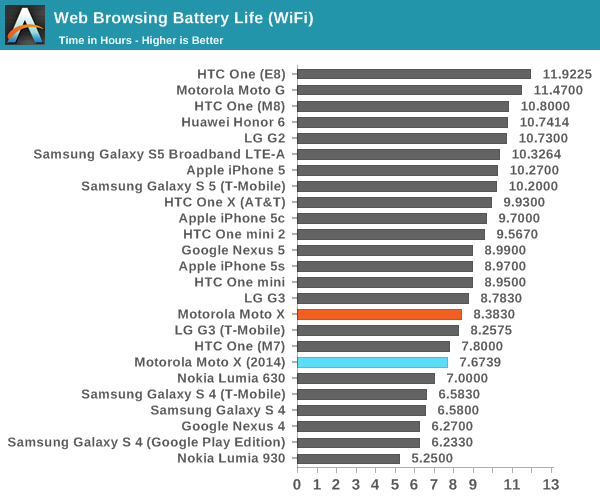
When running the web browsing test on WiFi, we see that the new Moto X manages to regress in battery life from the previous Moto X. This is a bit of an expected result as only the newer process of the SoC and new display technology can offset the decrease in battery size. In the LTE comparison there's a great deal more complexity as the previous Moto X had a less power efficient modem and RF front-end. The new Moto X has the same WiFi chipset as the previous Moto X, which is Qualcomm's WCN3680.
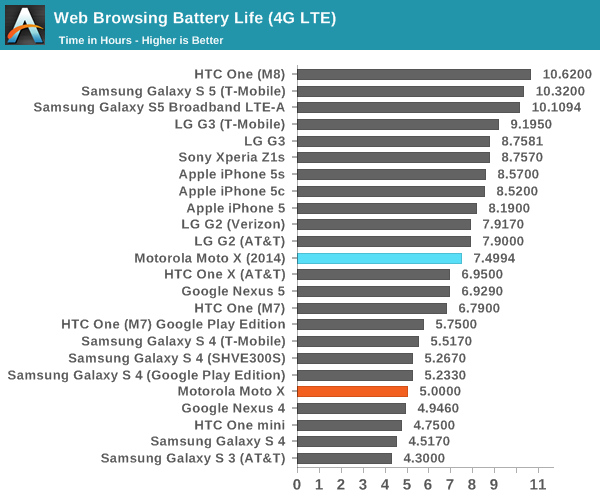
On LTE, the new Moto X is noticeably trailing behind the rest of the competition. Here we see that battery life is just behind the LG G2, but behind all recent Apple iPhones and just about every other Android high-end flagship phone launched in 2014. While the new Moto X has definitely improved over the previous Moto X, it seems that Motorola has used the newer AMOLED panel and lower power SoC to avoid using a significantly larger battery.
However, web browsing is not the only scenario worth testing. As the web browsing test is largely dominated by display power, it’s important that we test scenarios where all the other subsystems are more dominant in the power equation. For this, we turn to Basemark OS II and GFXBench 3.0, which focus more on CPU and GPU power consumption.
Unfortunately, I could not get our GFXBench rundown test to complete despite multiple attempts as it seems that the phone would either reboot or kill the application. Looking at the logs for the rundown test reveals that there’s no real change in FPS from run to run. After some extra investigation, it seems that this build (KXE21.187-43) doesn't do any throttling on GPU, so any workload that can keep the GPU at maximum heat output without dependence on CPU can cause the phone to reach unacceptable temperatures.
At any rate, the Basemark OS II run did complete so we can look at that.
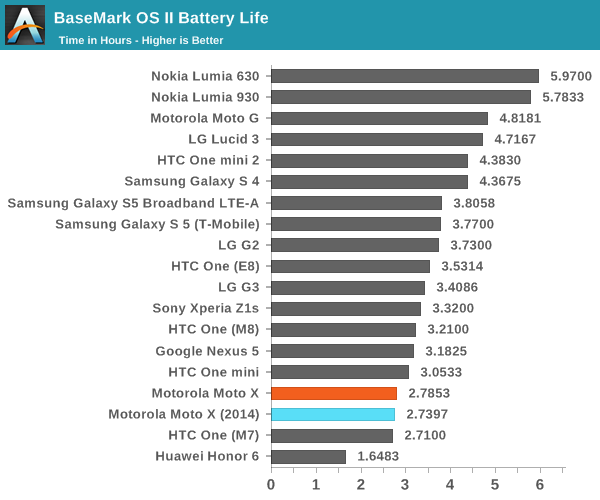
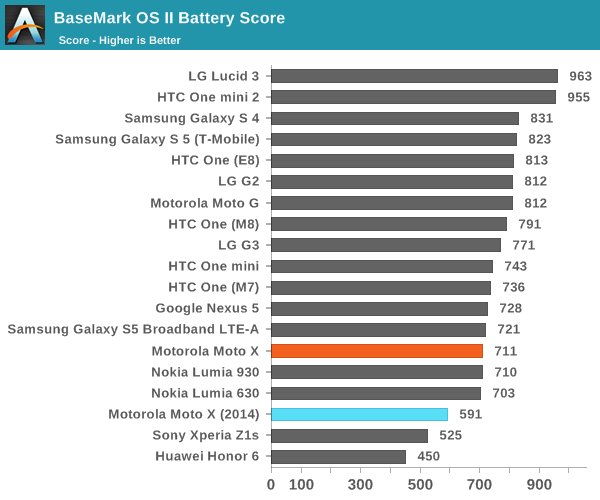
Unfortunately the Basemark OS II test reveals that battery life is poor compared to the competition. Normally, low battery life is compensated for by high performance but the battery score is only above the Sony Xperia Z1s and Huawei Honor 6, and the latter had no power budgeting mechanisms on the SoC to keep battery life at acceptable levels.
Overall, it’s hard to really say much in the way of praise for battery life. While it’s definitely surprising just how much battery life Motorola has achieved given the size of the battery and display, I suspect that Motorola found themselves in an uncomfortable situation as they tried to deliver a bigger display while keeping the phone easy to use with one hand. I suspect that all things considered, Motorola would have been better off if they went for a smaller display and the smaller height and width that would logically follow. It’s also not that the battery life is bad in an absolute sense, but it isn’t as good as its peers. Motorola is likely tracking closely to their estimated 24 hours of “mixed usage”. The use of Moto Display will also go a long way to reduce the time with the AP and display on.
Before I conclude this section, I just wanted to note that Android L alone won’t improve battery life on these tests. Android RunTime (ART) won’t help with battery life as these applications are native code. Job Scheduler is also irrelevant to our tests, as it will only improve battery life in situations where multiple applications are running in the background. We make every effort to ensure that no background tasks occur during these battery life tests and auto-sync is disabled as well in order to make sure that the only task running is the one under test. We have already run the data early in the summer on the Nexus 5 with Android L developer preview and our data does not show any significant difference in battery life. However, in real world usage where background applications and data syncing are active, one can expect greater battery life with Android L but only in the range of 10-15%.
Charge Time
While battery life from full charge to no charge is critical, in many situations the reverse is also important. For example, if one only has an hour before a flight, the rate at which the battery charges is just as important as the rate at which it discharges in use. In order to test this, the phone is connected to the included charger and the time from the battery begins charging to the time the charger stops drawing significant power is measured, as charging LEDs can often be an inaccurate method of determining charge time.
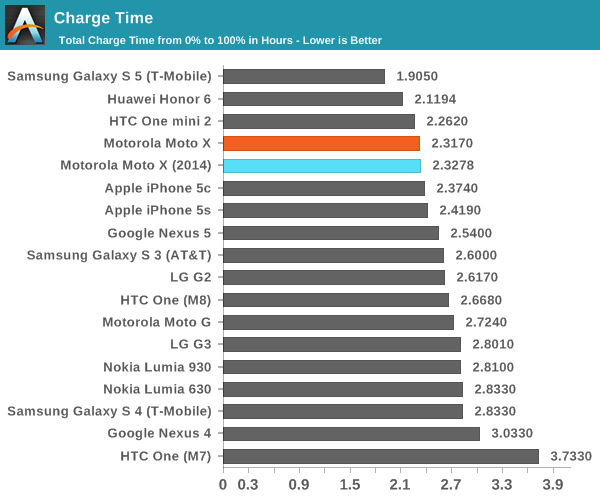
Motorola ends up on the high side here, which is somewhat expected due to the relatively small battery. I'm surprised that this is possible with a 5V, 1.15A charger though.


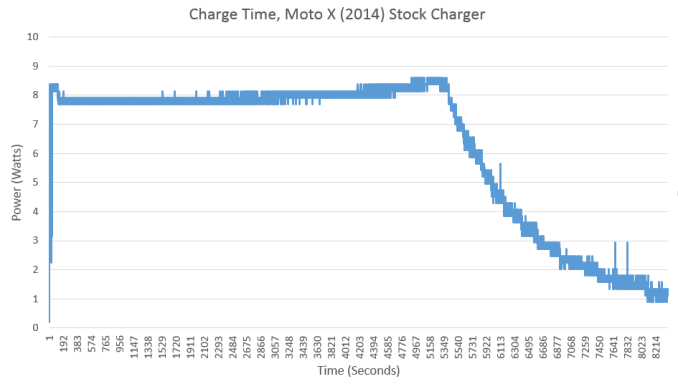








179 Comments
View All Comments
Alexvrb - Thursday, September 18, 2014 - link
Yeah the RAM and the CPU aren't that big of a deal to me, but if you're going to delete the mSD slot then your base model should be 32GB with a 64GB version as the upgrade.gg555 - Wednesday, September 24, 2014 - link
I agree. These days 16 Gb is a joke (which works out to more like 10 or 11 GB, once you account for the space the system takes up). These are multimedia devices. Once you start taking photos and video, downloading music and podcasts, doing some backups with Titanium or whatever, 16 GB really doesn't cut it. I struggle with this all the time on my Nexus 4.gg555 - Wednesday, September 24, 2014 - link
And they always want you to use the cloud as the solution to this problem. Seriously? Obviously they cannot possibly be ignorant about people having data caps on their plans. Not everyone can afford an unlimited plan. Or maybe this is just their way of colluding with the carriers to push people into more expensive plans. Anyway, the could is not a serious solution for a technology that has inherent network bandwidth issues.xaml - Saturday, September 27, 2014 - link
And security issues, which then reveal underlying issues with privacy, exhibitionism and respect. Not to mention the question of reliable access. And could it even be that data over radio is consuming more power than data over few or costly internal memory, respectively neglected external memory?erikiksaz - Tuesday, September 23, 2014 - link
Unlike Amazon, they're actually trying to make money off the hardware, hah. And I'm sure the cooling solutions for something of a tablet-sized form factor is much easier to tackle than on a smartphone.1080p on a 5.2 inch screen still results in a visible difference over 720p. 1440p, not so much.
bigstrudel - Thursday, September 18, 2014 - link
It's clearly the stock kernel which reduces battery runtimes on ALL nexus devices.julianocas - Thursday, September 18, 2014 - link
peGGi - Friday, September 19, 2014 - link
Kudos to Motorola for the impressive engineering that went into the metal-band-as-antenna. I like that about Motorola, that they put time and effort into things that users may not immediately notice, but should definitely improve the everyday quality of the experience of using a phone for its primary use - to make calls. But........ the metal band ruins the design, compared to X Gen 1, sadly. Screen-plate aside, the casing now seems to consist of 3 parts rather than 2. I loved the slopey, curviness of the first gen, and the way that the backplate curved round the sides, and met the front plate in the middle. That unity of design is gone now, and this second gen looks a bit awkward imo. The front and back of the phones don't match that well anymore. There was a lovely overall unity in aesthetic to the first Gen, which has been broken on the 2nd.
I also agree with the commenters that it is too big. Just like the S5, G3, and One M8 are all too big. For my very average sized male hands, the Gen One's ergonomics were perfect.
Sensors at the top on the front, especially on white model, look messy. Could they not all have been put behind one, long translucent black strip, along with the speaker grille, or something like that? Or tidied up a bit better?
I think Motorola would've been better sticking to the compact, ergonomically wonderful design of Gen 1, but with improvements to the internals (camera, SoC, colour accuracy, battery life). They'd have a great performing phone that fits better in the hand than all their rivals, for a lower cost than their rivals.
And then it would make sense to have a 5.5inch-ish size 'phablet' too, big screen, big tricks, etc. They'd be competing just above and just below the S5 and I'd say they'd rip chunks out of the market that way.
It looks like the Gen 1 is gonna go down as a classic, flawed and all as it was.
Harry_Wild - Friday, September 19, 2014 - link
I agree with your remark on the Moto X 2014! It much bigger then the Moto X which is great feeling and the right size for me small hands. But I am surprise Motorola went to a much larger size too! Motorola should of made the Moto X 2014 the same size; and they have the Moto G - 5" for anyone wanting a larger model. That would have been perfect decision. I going to the Apple store and looking at the 4.7" iPhone 6!dsouza - Friday, September 19, 2014 - link
@Harry_Wild, the new iPhone 6 (5.44 x 2.64in) is just marginally smaller than the Moto X 2014 (5.54 x 2.85)! So, if you believe that the new Moto X is too big for you, probably the new iPhone 6 will be so!